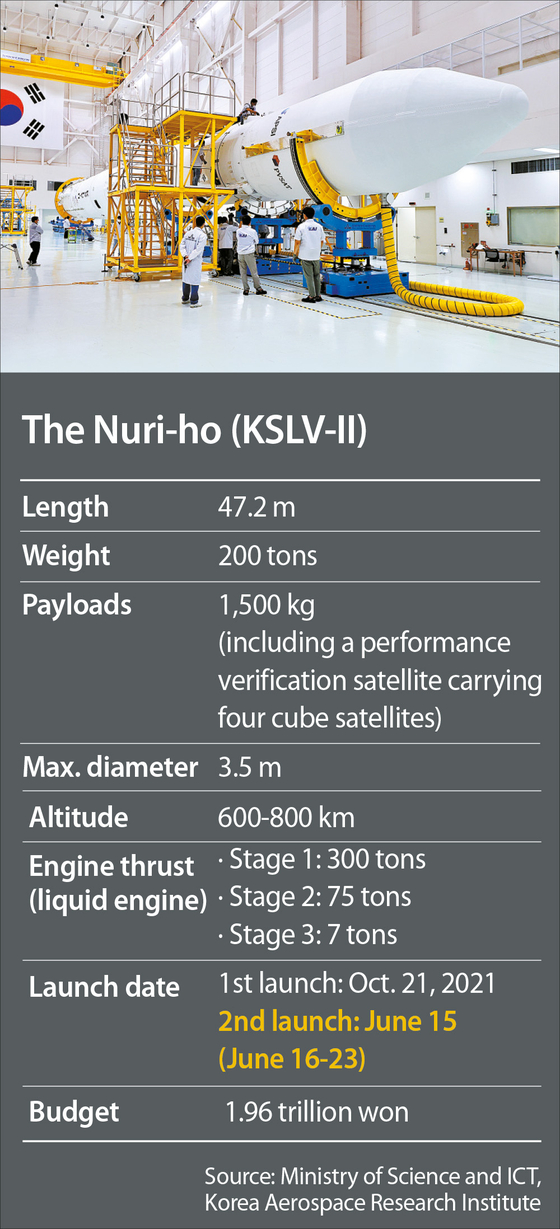Nuri-ho gets second chance to reach space next week
![The KSLV-II rocket is assembled at the launch vehicle assembly building at the Naro Space Center in Goheung County, South Jeolla, from Wednesday to Thursday. [KARI]](https://koreajoongangdaily.joins.com/data/photo/2022/06/10/3f24e519-65f1-4bba-918f-7d230e58c7ed.jpg)
The KSLV-II rocket is assembled at the launch vehicle assembly building at the Naro Space Center in Goheung County, South Jeolla, from Wednesday to Thursday. [KARI]
Korea is taking a second shot at launching its homegrown carrier rocket into space on June 15, after the first trial in October ended in partial success.
Unlike the first launch, which luckily carried a dummy payload, actual satellites will be on the rocket this time.
The Korea Aerospace Research Institute (KARI) held an online press event on Friday to share updates on the preparations to launch the Korea Space Launch Vehicle-II (KSLV-2), also known as the Nuri-ho.
“All three stages of the Nuri-ho have been assembled, and the vehicle is currently going through an electrical system inspection,” said Jang Young-soon, director of the launcher system development team. Jang explained that a final check of the rocket will be done over the weekend.
If the mission is successful, Korea will become the seventh nation to succeed in launching a satellite of more than 1 ton following Russia, the United States, the European Union, China, Japan and India. Israel, Iran and North Korea have succeeded in launching satellites weighing less than 300 kilograms.

The KSLV-II is a three-stage, liquid-fueled carrier rocket developed entirely with homegrown technologies. A total of 1.96 trillion won ($1.5 billion) has been spent on the KSLV-2 since 2010.
The KSLV-2 is set to lift off from a launch pad at the Naro Space Center in Goheung County in South Jeolla, on June 15. The launch date may change to between June 16 to 23 depending on weather conditions.
The rocket will be transported to the pad and erected in a vertical position a day before the launch. After going through a final inspection and fueling process, an automatic launch operation will be initiated for liftoff.
![KSLV-2 rocket lifts off from the Naro Space Center in Goheung County, South Jeolla, during its first launch on Oct. 21, 2021. [YONHAP]](https://koreajoongangdaily.joins.com/data/photo/2022/06/10/2d8685e0-6ada-4aff-a278-5be4640dced1.jpg)
KSLV-2 rocket lifts off from the Naro Space Center in Goheung County, South Jeolla, during its first launch on Oct. 21, 2021. [YONHAP]
During the first launch of the KSLV-2 last Oct. 21, the rocket successfully went through the separation of the first and second stage boosters and hit its target altitude of 700 kilometers (435 miles), but the dummy payload failed to stay in the targeted 700-kilometer orbit.
The last-minute glitch was due to a faulty design of an oxidizer tank, which led to the shutting down of the third-stage engine.
“Technological adjustment to the second launch vehicle was completed in April, after running ground tests in early this year,” said Jang.
The second rocket will carry 1,500-kilogram payloads into orbit 700 kilometers above the Earth, and this time, they will be actual satellites.
The payloads include a performance verification satellite, developed by Seoul-based company Asia Pacific Satellite, which will verify the performance during the launch and separation process. The performance verification satellite is cube-shaped, roughly 1 meter in width, length and height, and will carry four cube satellites (CubeSat) as well.
![A rendering image of the performance verification satellite developed by Asia Pacific Satellite. [KARI]](https://koreajoongangdaily.joins.com/data/photo/2022/06/10/c3efe5be-a52c-4a84-addd-989dd473f265.jpg)
A rendering image of the performance verification satellite developed by Asia Pacific Satellite. [KARI]
The four CubeSat are: STEP Cube Lab-II developed by Chosun University; Snuglite-II by Seoul National University; Miman by Yonsei University; and Randev by KAIST.
Chosun University’s STEP Cube Lab-II consists of six cube units, meaning it is around 60 centimeters in length, the biggest of the four. Its mission is to observe the heat flow on the Earth for a year. Seoul National University’s Snuglite-II has three units, and will also observe the Earth by collecting GPS carrier signals over one year.
Yonsei University’s Miman and KAIST’s Randev both consist of three units. Miman’s mission of monitoring fine dust with a high-performance camera will last for at least six months. Randev will observe the Earth for six months using hyperspectral cameras.
If the KSLV-II successfully delivers its payload, the next step will be improving Korea’s space capabilities and enhancing the reliability of the homegrown launch vehicles, said KARI. The Korea Space Launch Vehicle Advance Project, which will run from 2022 through 2027, is currently underway, with an estimated budget of 687.4 billion won.
BY SHIN HA-NEE [shin.hanee@joongang.co.kr]










with the Korea JoongAng Daily
To write comments, please log in to one of the accounts.
Standards Board Policy (0/250자)